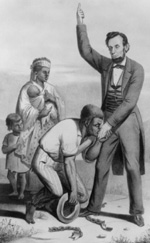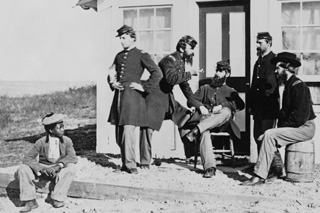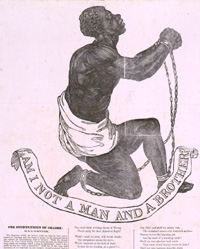Maryland Commentary
companion video - Dr. Ray Winbush, Director, Institute for Urban Affairs, Morgan St. University
companion photos
The justification for slave insurrections (revolts)
 It is important to note that there were other factors, including the physical, social, emotional, spiritual, and intellectual, maturity of the Africans that spearheaded their thoughts, plans, and actions for liberation. Let’s keep in mind that we are speaking about men and women who’s only difference from the American enslaver was language and that barrier was lifted in a matter of a years. )
It is important to note that there were other factors, including the physical, social, emotional, spiritual, and intellectual, maturity of the Africans that spearheaded their thoughts, plans, and actions for liberation. Let’s keep in mind that we are speaking about men and women who’s only difference from the American enslaver was language and that barrier was lifted in a matter of a years. )
These Africans used their intellect, insights, and new language, to determine who, when, where, and how their movements for liberation would gather support from others. Over the years of enslavement, African leaders observed the tensions that arose over conflicts of interest here in the United States between white nationals as well as similar conflicting interest with their international conspirators, and used them as barometers to gauge the appropriate time for a plan or action of liberation.
The war of 1812, the Mexican War, the French Revolution, the rebellion by Africans in the West Indies, and others, were periods of financial and emotional discomfort for the white gentry and fueled the fire for slave insurrections in the United States. The tension between the United States and France in 1797 through 1799 provided inspiration to Gabriel’s planned insurrection in 1800.
 Although the abolitionist movement was initiated by the African him/herself, it was energized by Abolitionist writers such as William Lloyd Garrison and David Walker. In his commentary of 1829 entitled "Walkers Appeal", Walker’s message to the slaves was direct: "If liberty is not given you, rise in bloody rebellion." http://africawithin.com/bios/david_walker.htm
Although the abolitionist movement was initiated by the African him/herself, it was energized by Abolitionist writers such as William Lloyd Garrison and David Walker. In his commentary of 1829 entitled "Walkers Appeal", Walker’s message to the slaves was direct: "If liberty is not given you, rise in bloody rebellion." http://africawithin.com/bios/david_walker.htm
There were varying reasons, some religious, moral, economic, self preservation, or "for the security of the democratic rights of the white people"1, that the movement for the abolition of slavery gained popularity among whites and exhorted by the Methodist and Quakers. It should also be noted that, in 1796 20% of Methodist were Negroes.2
 The first and most identifiable image of the 18th century abolitionist movement was a kneeling African man. It was entitled "Am I Not A Man and A Brother?" Although the intent and the effect of the emblem was to focus public opinion on the evils of the African slave trade, its ultimate effect was to underscore the perception of black inferiority. The supplicant posture of blacks persisted as a standard feature of Western art long after slavery was abolished. (such can be seen today in the Rotunda of the Capitol Building in Washington, DC as you view the sagging shoulders on the small bust of Dr. Martin L. King Jr.)
The first and most identifiable image of the 18th century abolitionist movement was a kneeling African man. It was entitled "Am I Not A Man and A Brother?" Although the intent and the effect of the emblem was to focus public opinion on the evils of the African slave trade, its ultimate effect was to underscore the perception of black inferiority. The supplicant posture of blacks persisted as a standard feature of Western art long after slavery was abolished. (such can be seen today in the Rotunda of the Capitol Building in Washington, DC as you view the sagging shoulders on the small bust of Dr. Martin L. King Jr.)
Ironically, although the image became the emblem of the anti-slavery movement, the Society for Effecting the Abolition of the Slave Trade was emphatic that its only goal was the abolition of the slave trade, not of slavery itself. That position was vigorously protested by individual members such as Granville Sharp, the most influential abolitionist of his time.
The following link contains the copy of the text in its entirety.http://www.pbs.org/wgbh/aia/part2/2h67.html
"No nation can enslave a race of people for hundreds of years, set them free bedraggled and penniless, pit them, without assistance in a hostile environment, against privileged victimizers, and then reasonably expect the gap between the heirs of the two groups to narrow. Lines, begun parallel and left alone, can never touch"3
After a few days of viewing the above information, we will continue our ride into history. Also, for daily updates and podcast on the AMAAP journey visit NJ.com and type in "Where is Miles Dean " in the search box.
We invite you to add comments on the content of this web site on our blog. In addition, we will post commentaries during this ride from guest writers as we proceed across the country.
1 H Aptheker "American Negro Slave Revolts" p. 373 2 H Aptheker "American Negro Slave Revolts" p. 102 3 Randall Robinson "The Debt" p. 74
Images courtesy of: Library of Congress: [American Memory - Prints and Photographs Reading Room] Library of Congress: [American Memory - Prints and Photographs Reading Room] - Civil War(1862)